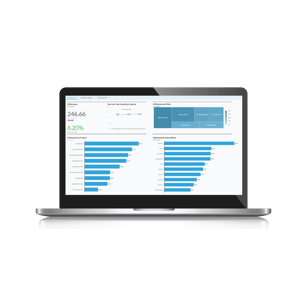BW/4HANA
SAP BW/4HANA ist eine moderne Data-Warehouse-Lösung, die auf der SAP HANA-In-Memory-Technologie basiert. Sie kombiniert Live-Daten mit historischen Daten für Echtzeitanalysen und ermöglicht schnelle, fundierte Entscheidungen. Als Nachfolger von SAP BW 7.5 on HANA ist die Plattform vollständig in die HANA-Technologie integriert und bietet dadurch eine verbesserte Performance und Effizienz.
SAP BW/4HANA: Die nächste Generation des Datenmanagements
Mit der Einführung von SAP HANA im Jahr 2010 wurde die Basis für eine schnellere Datenverarbeitung geschaffen. SAP BW/4HANA baut auf dieser Technologie auf und bietet die erste Data-Warehouse-Lösung, die sowohl Transaktionen als auch Analysen in Echtzeit unterstützt. Diese Echtzeitfähigkeit ermöglicht es Unternehmen, Daten schnell und effizient für Entscheidungsprozesse zu nutzen.
Für die Bereitstellung der Daten zu Reporting- und Visualisierungszwecken bietet BW/4HANA verschiedene Schnittstellen an, mit deren Hilfe Client-Applikationen (wie SAP Analytics Cloud) aufbereitete Daten konsumieren können.
Die Unterstützung für ältere SAP BW-Versionen endet 2027, mit einer optionalen Verlängerung bis 2030. Unternehmen, die auf eine zukunftssichere Lösung setzen, sollten rechtzeitig auf BW/4HANA umsteigen, um von den modernen Funktionen und der verbesserten Performance zu profitieren.

SAP BW/4HANA: Echtzeitanalysen und Big Data
SAP BW/4HANA ist speziell darauf ausgelegt, große Datenmengen aus operativen SAP-Systemen zu integrieren und in Echtzeit zu analysieren. Die In-Memory-Technik von HANA ermöglicht nicht nur schnelle Datenverarbeitung, sondern auch die Durchführung komplexer analytischer Kalkulationen. Mit vordefinierten Funktionen in Data Engines wie Predictive Analytics oder HANA Spatial können Unternehmen datengetriebene Strategien umsetzen.
Einfachere Administration und Modellierung
Die Plattform reduziert die Komplexität durch neue Objekte wie Advanced Data Store Objects (ADSO) und CompositeProvider, die ältere Strukturen wie InfoCubes und DSOs ersetzen. Die Modellierung erfolgt über die Eclipse-basierten BW Modelling Tools, das auch den früheren BEx Querydesigner integriert. Unternehmen haben zudem die Wahl zwischen einer On-Premise- und einer Private Cloud-Version, wobei die Private Cloud-Variante den administrativen Aufwand deutlich verringert, da SAP die Wartung übernimmt.
Migration
-
Greenfield-Ansatz
Der Greenfield-Ansatz beschreibt eine Neuimplementierung, bei der bestehende Systeme neu aufgebaut und relevante Daten aus Quellsystemen migriert werden. Dies bietet die Möglichkeit, eine moderne Architektur von Grund auf zu gestalten.
-
Brownfield-Ansatz
Beim Brownfield-Ansatz wird die bestehende Systemlandschaft schrittweise auf BW/4HANA migriert. Die Umstellung erfolgt über Migrationstools wie die „SAP Database Migration Option“ (DMO) und das „SAP BW/4HANA-Starter-Add-On“. Legacy-Objekte werden dabei in HANA-optimierte Objekte umgewandelt. Die Komplexität der Migration hängt stark von den bestehenden Applikationen ab. Sie kann vom Umfang eines größeren Release-Upgrades bis zu mehrmonatigen oder jahrelangen Projekten reichen.
Resümee
Ein Wechsel zu SAP BW/4HANA ist aktuell nicht zwingend erforderlich, doch mittelfristig wird die Plattform für Unternehmen unverzichtbar, die Echtzeitanalysen und Big Data nutzen möchten. Neue Implementierungen sollten direkt mit SAP BW/4HANA erfolgen, um von der verbesserten Architektur, den Echtzeitfähigkeiten und der vereinfachten Administration zu profitieren.
SAP BW/4HANA – Die wichtigsten Merkmale auf einen Blick
SAP BW/4HANA fasst die wichtigsten Funktionen und Vorteile moderner Datenanalyse und -verwaltung in einer einzigen Plattform zusammen. Die folgenden Kacheln geben Ihnen einen schnellen Überblick über die zentralen Merkmale, die diese Lösung auszeichnen.
Integration von Künstlicher Intelligenz (KI)
SAP BW/4HANA ermöglicht die Einbindung von KI-Funktionen, um erweiterte Analysen und Prognosen durchzuführen. Dies unterstützt datengetriebene Entscheidungen und fördert Innovationen.
Echtzeit-Datenverarbeitung
Durch die In-Memory-Technologie von SAP HANA verarbeitet BW/4HANA große Datenmengen in Echtzeit. Dies ermöglicht sofortige Einblicke und beschleunigt Geschäftsprozesse.
Vereinfachte Datenmodellierung und -verwaltung
Die Plattform bietet intuitive Werkzeuge zur Datenmodellierung und -administration, die den Entwicklungsaufwand reduzieren und die Implementierung von Änderungen beschleunigen.
Integration mit SAP- und Drittanbieteranwendungen
SAP BW/4HANA verbindet sich nahtlos mit verschiedenen Datenquellen und Anwendungen, wodurch die Datenintegration effizienter und kostengünstiger wird.
Skalierbare Big-Data-Verarbeitung
Die Lösung ist darauf ausgelegt, große Datenmengen zu verarbeiten und unterstützt Unternehmen dabei, das volle Potenzial ihrer Daten auszuschöpfen.
Intuitive Benutzeroberfläche
Mit einer benutzerfreundlichen und modernen Oberfläche steigert BW/4HANA die Produktivität der Anwender und reduziert die Notwendigkeit für Schatten-IT.
Flexible Bereitstellungsoptionen
SAP BW/4HANA kann sowohl lokal (On-Premise) als auch in der Cloud implementiert werden, um den individuellen Anforderungen und Strategien Ihres Unternehmens gerecht zu werden.
Zukunftssichere Plattform
Mit kontinuierlichen Updates und einem langfristigen Support bietet BW/4HANA eine stabile Grundlage für zukünftige Geschäftsanforderungen und technologische Entwicklungen.
